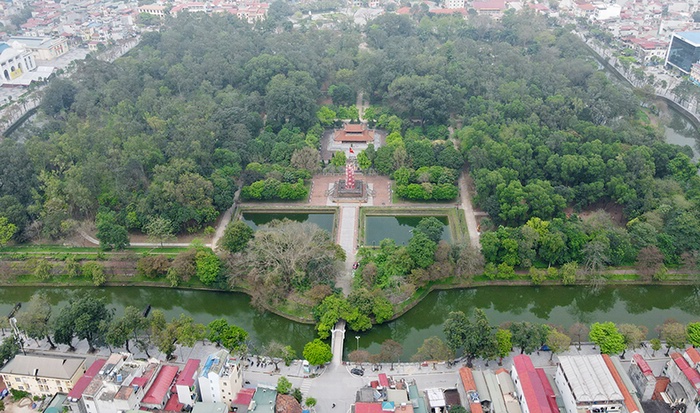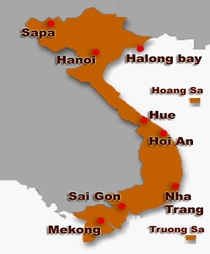
Son Tay ancient citadel

Son Tay ancient citadel is known to many people for its precious cultural
and historical values associated with its role as the center of a region of Doai,
once located west of Thang Long citadel. It has affirmed the role and position
in terms of economic, military, cultural, and trade factors of a diverse and
large geographical area. Doai region culture is an important pole in the
existence and common development of the culture of ancient Thang Long and
today's capital Hanoi.
Son Tay ancient citadel is 200 years old (1822 - 2022), established during the
3rd year of King Minh Mang (1822). The Nguyen Dynasty had to send mandarins from
the region to search and select for the third time to find a location and land
favorable to heaven - earth - people to build the citadel.
The laterite citadel was built in the architectural style of Vauban (an engineer
who later became a marshal of France), converging the elements and properties of
a solid military citadel with military and defense works. The palace, the
office, the flag tower, the city wall, the four gates, the governor's house, the
armory, the residences of mandarins and soldiers and their families, and even
prisons...
Son Tay ancient citadel has existed and is also known as the town of Son Tay
province since 1831. The citadel existed for 61 years under the reigns of the
Nguyen Dynasty (1822 - 1883) before being attacked by the French expeditionary
force. After three attacks from Hanoi by waterway and road to the citadel, the
French army was able to defeat the citadel with the strength of their weapons,
combat experience, and superior plotting tactics. In addition to the great value
of its military defense position, the center of economic, cultural and social
development of the whole region (today, near the Bac Thanh gate, there is also
the Hung Hoa Bishop's Palace, which is also the headquarters for the province).
Catholic activities of the Western and Northeast provinces). Son Tay ancient
citadel with its large and majestic old buildings has proven the hard work and
creativity of the people, scholars, and soldiers inside and outside this Doai
region. Therefore, in 1924, the governor-general of Indochina issued a decree
classifying items in the ancient citadel, including the Vong Cung palace, as
cultural heritage of An Nam and assigned it to the School of the Far East to
manage.
With a total area of 20 hectares, including 16 hectares of ground, 4 hectares
of water surface (the moat has a length of 1,795m, running around the citadel,
the drain into the moat is taken from the Red River, the drain out is opened and
pushed into the Tich river). Son Tay ancient citadel has a quadrilateral shape,
with a circumference of 1,394m. Although before being classified as a cultural
and historical relic by the state in 1994, the construction items in the citadel
relic were almost gone and looking at them were only vestiges of old
foundations. What remains over the years are two ancient gates, West and South,
two water wells and a system of trees and grass. Until now there have been a
number of items inside and outside the monument that the state has invested in
restoring according to the old model such as: Vong Cung, Ky Dai, campus, Doan
Mon, laterite wall around the three dimensions of the gate. West - South - North
and a system of walls and sidewalks made of blue stone. Historical sources about
the ancient citadel are also provided to the locality by many scholars and
people inside and outside the town to serve the work of managing, preserving and
embellishing the monument, including documents left by the French during their
military march to the Son Tay region at that time.
It can be affirmed that: Son Tay ancient citadel still exists spatially intact
to this day, from the surrounding bustling neighborhoods, passing through the
moat (2 gates) is a relic area dating back 2 centuries, a quiet, airy forest in
the heart of the town, surrounded by heritage, covered with green leaves in all
four seasons, which is a huge contribution of the community.
Coming to the citadel, everybody feels like they can reminisce and admire a
unique citadel with outstanding values ??in terms of architecture, age, fine
arts, location, and citadel construction techniques. Laterite was the main
building material, unlike other citadels in the Tonkin at that time that were
built with terracotta bricks or green stone. Through the stages, the works in
the citadel continued to be consolidated. It is worth noting that a whole road
was also designed in the citadel, which people call "Tuong Dao" (the path of the
elephant). There is an elephant belonging to the Governor of Son Tay that has
been passed down with very emotional stories between it and the owner in the
battle to protect the citadel.
In addition, the Son Tay ancient citadel also contains valuable resources such
as the well water drilled from the southern laterite seam was explored and
discovered by the French in 1932, after which a water pumping station was built
to serve the daily needs of the people around the citadel, most especially is
tens of thousands of large and small species living and growing, including
animals and plants from different levels and species such as above ground,
underground, under water. The soil in the citadel must have many nutritional
elements to add vitality to the growth of all species of trees.
Son Tay ancient citadel has become a precious cultural tourist destination that
attracts a large number of visitors who must visit when on their trip to Son Tay.
It is a red address in the Doai region cultural area, the gateway to the west of
Hanoi capital city.
Footprint Vietnam Travel is a
local tour operator offering private family tours to all popular tourist
destinations in Vietnam like Hanoi, Ho Chi Minh, Nha Trang,Phan Thiet, Hoi An,
Hue, Phu Quoc...

Vietnam Travel Information
Customize your trip

Testimonials
Dear Ms Helen Pham
We had a wonderful amazing trip and will return as soon as we can afford it again. Thank you so much! I will write a great review on tripadvisor. Really the guides and hotels and tours were awesome. Ms. Nhung was very sweet and refreshingly honest, very likeable. Mr. Tam was fantastic, highly knowledgeable and funny. Probably our best "tour" was the day we spent on motor bikes visiting the tombs near Hue. The bikes allow for a much more intimate view of the countryside. And then - as I wrote - Mr. An was absolutely the best guide ever...Read more